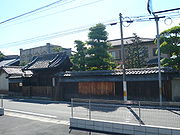
Kiyosu-juku
Encyclopedia

Shukuba
were post stations during the Edo period in Japan, generally located on one of the Edo Five Routes or one of its sub-routes. They were also called shukueki . These post stations were places where travelers could rest on their journey around the nation...
of the Minoji
Minoji
The was a highway in Japan during the Edo period. It was a secondary route, ranked below the Edo Five Routes in importance, and connected Miya-juku on the Tōkaidō with Tarui-juku on the Nakasendō....
. It is located in the city of Kiyosu
Kiyosu, Aichi
was a town located in Nishikasugai District, Aichi, Japan., the town had an estimated population of 19,409 and a density of 3,696.95 persons per km²...
, Aichi Prefecture
Aichi Prefecture
is a prefecture of Japan located in the Chūbu region. The region of Aichi is also known as the Tōkai region. The capital is Nagoya. It is the focus of the Chūkyō Metropolitan Area.- History :...
, Japan
Japan
Japan is an island nation in East Asia. Located in the Pacific Ocean, it lies to the east of the Sea of Japan, China, North Korea, South Korea and Russia, stretching from the Sea of Okhotsk in the north to the East China Sea and Taiwan in the south...
.
History
Kiyosu-juku was originally formed as a castle townCastle town
A castle town is a settlement built adjacent to or surrounding a castle. Castle towns are common in Medieval Europe. Good example include small towns like Alnwick and Arundel, which are still dominated by their castles...
for Kiyosu Castle
Kiyosu Castle
is a castle that acted as a base of operations for Oda Nobunaga during the latter half of the Sengoku period of feudal Japan. It is located in the city of Kiyosu, Aichi Prefecture, Japan....
; however, the original town was decimated when much of the populace was moved to Nagoya Castle
Nagoya Castle
is a Japanese castle located in Nagoya, central Japan. During the Edo period, Nagoya Castle was the center of one of the most important castle towns in Japan—Nagoya-juku— and it included the most important stops along the Minoji, which linked the Tōkaidō with the Nakasendō.-History:In...
. Kiyosu-juku was established in 1602, after the Minoji was established to connect the Nakasendō
Nakasendo
The , also called the , was one of the five routes of the Edo period, and one of the two that connected Edo to Kyoto in Japan. There were 69 stations between Edo and Kyoto, crossing through Musashi, Kōzuke, Shinano, Mino and Ōmi provinces...
and the Tōkaidō
Tokaido (road)
The ' was the most important of the Five Routes of the Edo period, connecting Edo to Kyoto in Japan. Unlike the inland and less heavily travelled Nakasendō, the Tōkaidō travelled along the sea coast of eastern Honshū, hence the route's name....
. Though the post station and the castle share the same name, different kanji
Kanji
Kanji are the adopted logographic Chinese characters hanzi that are used in the modern Japanese writing system along with hiragana , katakana , Indo Arabic numerals, and the occasional use of the Latin alphabet...
were used to write the name: 清洲 was used for the castle, while 清須 was used for the post station.
Ruins of the post town's honjin
Honjin
thumb|250px|The honjin at [[Inaba Kaidō]]'s [[Ōhara-shuku]]. is the Japanese word for an inn for government officials, generally located in post stations during the later part of the Edo period.-Evolution of Honjin:...
can still be found today, just south of Kiyosu Park. The Meiji emperor
Emperor Meiji
The or was the 122nd emperor of Japan according to the traditional order of succession, reigning from 3 February 1867 until his death...
stayed in the honjin while traveling during his reign.

